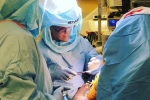Surgical Treatment Options for Irreparable Rotator Cuff Tears

Welcome back to The Sports Docs Podcast with Dr. Catherine Logan and Dr. Ashley Bassett. In episode 16, we’re going to continue our discussion with Dr. Anand Murthi and focus on the surgical treatment options for irreparable rotator cuff tears.
We’ll start with the article titled “Minimum 2-year Clinical Outcomes After Superior Capsule Reconstruction Compared With Reverse Total Shoulder Arthroplasty for the Treatment of Irreparable Posterosuperior Rotator Cuff Tears in Patients Younger Than 70 Years” from December 2020 issue of JSES. Peter Millett and colleagues at the Steadman Clinic in Vail reported significant improvements in clinical outcome scores, high patient satisfaction and high rates of return to sport at 2-years post-op, with no significant differences between the two procedures. The authors concluded that SCR is a reliable alternative to arthroplasty for younger patients with irreparable cuff tears in the absence of glenohumeral arthritis. SCR has the benefit of being an arthroscopic procedure that preserves native anatomy, allowing for easier revision surgery in the future.
Then, from the June 2019 issue of JBJS, we review the publication “Biomechanics of a Biodegradable Subacromial Balloon Spacer for Irreparable Superior Rotator Cuff Tears.” Authored by our guest Anand Murthi and his team at MedStar, this laboratory study found that placement of a subacromial balloon spacer in the setting of a massive irreparable supraspinatus tear restored glenohumeral contact pressures and the center of glenohumeral contact to that of an intact rotator cuff. Additionally, placement of the balloon increased the deltoid load and lowered the humeral head, increasing the acromiohumeral interval and decreasing subacromial contact pressures. The authors concluded that the subacromial balloon spacer may help overcome the biomechanical effects of a deficient cuff and thereby postpone the need for arthroplasty.
Lastly, we finish up with a systematic review from the July 2020 issue of JSES titled “The Lower Trapezius Transfer: A Systematic Review of Biomechanical Data, Techniques and Clinical Outcomes.” Two tendon transfers have been described for treatment of irreparable posterosuperior rotator cuff tears: latissimus dorsi and lower trapezius. Compared to traditional latissimus dorsi transfer, the lower trap transfer is more anatomic and better restores shoulder abduction and external rotation. One drawback of the lower trap transfer highlighted by this paper is limited tendon excursion requiring the addition of a graft. In the setting of a cuff tear, direct transfer to the tuberosity without graft extension increases muscle tendon strain and risk of failure, and therefore is not recommended. Lower trap transfer can be performed through an open or arthroscopically-assisted approach while latissimus dorsi transfer can also be performed entirely arthroscopically.







